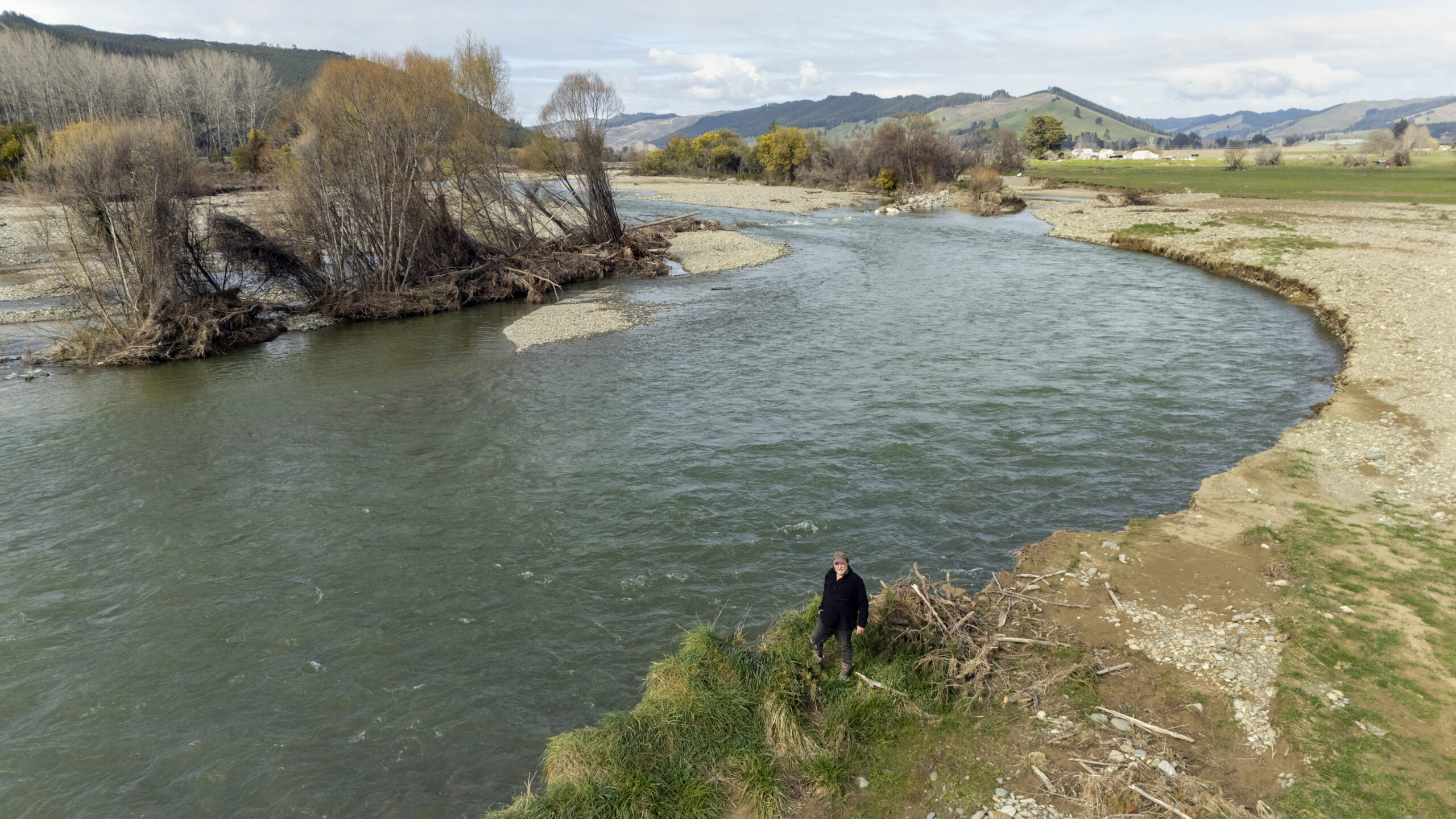By Fiona Terry
Copyright farmersweekly

Reading Time: 5 minutes
Whenever it rains, Jason Diack and wife Maree watch the Motueka River take more of their land. It now runs for 300m through their property, instead of along the boundary, and fields that were previously prime grazing are now unusable.
“Before the floods, you’d get well over 100 bales of winter feed from one of the lower paddocks and you could have landed an airplane on it, it was that flat, not a stone to be seen,” said Diack.
“Now, what hasn’t washed away is unusable, buried underneath rocks, sand and gravel.”
Their farm was one of those severely impacted by the two Tasman flood events of June and July, which saw a State of Emergency declared.
Two months on and farmers across in the region are now juggling the clean-up with lambing and calving.
At the Diack’s 52 hectare property in Kohatu, during the flood, 17-20ha was under water. Troughs and gateways disappeared and irrigation hydrants were destroyed.
Despite trying to lift his deer fencing – at times Diack was waist-deep in water – the force of the flooding destroyed 3.2km of it, including wiping out posts that had been standing solid for 43 years.
“Everything’s buggered,” Diack said.
“It was all very tidy before – we had fruit trees along the river, and I’d made banks and put up fences so stock couldn’t touch it – we’d spent a lot of money down there but that’s all gone, and land’s still being washed away.”
Dairy cows that used to graze the property needed relocating and the couple have 50 ewes in lamb, and 53 heifers and steers grazing, but luckily have some higher ground.
“We’re cleaning up bits as we can but replacing the deer netting alone will cost around $17k, and that’s without the posts.”
Volunteers from Lincoln University helped put up a temporary boundary fence and the couple have applied to the Ministry for Primary Industries for help with bulldozers and diggers.
“I’ve done what I can but it needs the big equipment so I’m hoping for some help with that otherwise the river’s going to keep chipping away and taking more.”
The Diacks aren’t alone, said Kerry Irvine, Federated Farmers Nelson president.
“In multiple places the river changed course through farms so people have lost land,” said Irvine.
“It’s literally been washed away. The clean-up will take years.”
Irvine’s farm boundaries the Motueka River and flooding on his property took fences and dumped debris in paddocks, but he considers himself fortunate he didn’t lose land itself.
Now busy with lambing and calving on 700ha, with a lease block of 50ha, there’s little time for clean-up and repairs.
“It’s made stock management for those impacted much harder,” said Irvine, who runs 1000 ewes, 150 cattle and 200 winter trade lambs.
“Some of the fences aren’t there anymore and if they are they’re likely damaged or not stock proof.”
Federated Farmers was among those organisations contributing funds to the clean up effort, as were HortNZ, the government, and Rural Women New Zealand through its Adverse Events Relief Fund. A Mayoral Fund reached $477,000 and saw 258 applications requesting help totalling $3.6m. The Primary Sector Recovery Fund of $340,000 saw 62 applications requesting help totalling nearly $2.6 million.
Top of the South Rural Support Trust has experienced an increase in people needing access to emotional support.
“Some are really struggling,” said chair Richard Kempthorne.
“We have a trained counsellor who is involved with several people and can help others coming through too.
“There is still a lot to do. The clean-up is happening gradually – it’s a matter of taking one bite at a time.”
Community events have helped buoy spirits. Local company RePost has been supplying free fence posts, and a Rapid Relief team also donated fencing supplies. Supplement feed has been sent to the district, donated by contractors in Canterbury and boosted by a contribution from Young Farmers.
Members of the Student Volunteer Army have been rolling up their sleeves, Taskforce Kiwi is also mucking in, and crews from Enhance Taskforce Green are still in full operation.
“They are all doing such marvellous work and are so appreciated by the people they’re helping,” said Kempthorne.
“At this stage there’s a contract for Enhanced Taskforce Green through to early October and we’re hoping that will be extended.”
One farmer on the list for help from Enhanced Task Force Green is Andrew Fry, whose 41ha property in Motupiko was shattered when the river it had previously bordered spilled over, leaving a trail of destruction.
What used to be productive land for baleage, maize, grazing and hops was overrun by the raging river, which spewed thousands of tons of rocks, gravel and silt, ripping out fencing, and flooding the sheds of his agricultural contracting business.
A successful attempt by Fry and his team to re-route the river to its original course following the first floods took 10 days. Their efforts were destroyed, though, when the second flood occurred less than two weeks later.
With the river now having permanently changed course across his block, the battle is on to prevent more erosion and devastation, said Fry.
“We’ve lost $150,000 worth of land here. The riverbed’s now really shallow and it’s getting worse.
“I expect to lose a bit of fencing on the riverside, but we lost the fence right to the road – 1.3km of it in total.”
In addition, the irrigation system was impacted, with a pump shed lost.
“Our financial loss is currently around $116,000, with hired help, including paying someone to do the stopbank for us, but that’s not including our own gear and maintenance costs and my own staff because we’ve all been working flat-out on the clean-up since the floods.”
So far he’s shifted 12,000 tonnes of gravel and rocks into piles at his Motupiko paddocks, with much more still left to go.
“It’s a bit scary rolling into next season without the money to do maintenance because that’s all been eroded by the erosion!”
The Fry family has been farming in Tasman for six generations and has other properties in the Motueka Valley, where Andrew grows maize. At one 20ha block the floodwater reached two metres high, swamping a combine harvester that still bears the water marks.
“All we’ve been doing since the first event is cleaning up. It makes me want to give up but then what do you do? We’re just lucky we know enough people and we’ve got some ability – and if we don’t do it, the farm’s useless.”



